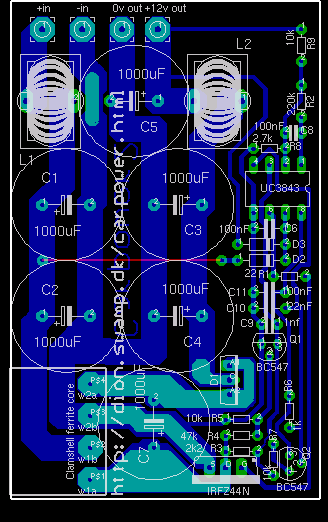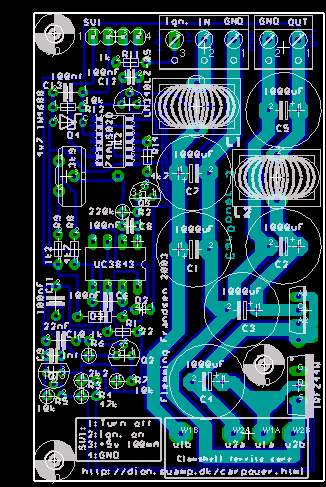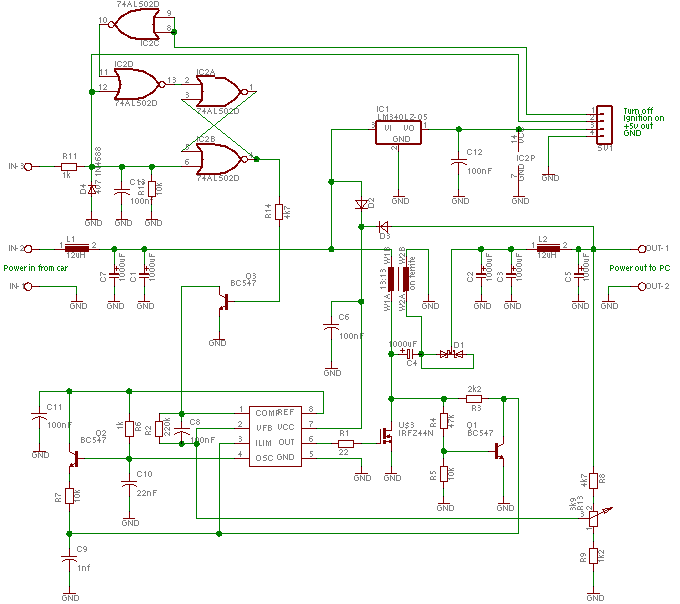Many projects need a good clean +12V at a couple of amps (like a
small PC or a laptop) and although a car has a 12V battery the actual
voltage available is everything from 9V to 16V and there is plenty of
dirt in the powerline as well, to to run delicate electronics you need
to clean up that power source before use.
Bob Blicks solution
It turned out that a clever dude called
Bob Blick was here before me and solved the problem back in 2001,
so I simply chose to ape him:) This next section contains the
power supply information that I have mirrored here:
![The Blick DC/DC converter [follow link for high-res] The Blick DC/DC converter [follow link for high-res]](carpower/blick-power-small.png)
The power supply accepts 8 to 16 volts and produces 12 volts. The
topology is SEPIC (single-ended primary inductance converter), the
advantage being the ability to convert up or down with a minimum of
parts and maximum efficiency. [...] the power supply is good for
about 8 amps output and can power the system while starting the
car.
SEPIC topology uses two inductors, but if you couple them your
efficiency goes up. Don't go calling it a transformer, though :) I
used an RM10 core, I don't know the exact material. It is wound in
bifilar fashion. I used a bit of sticky label to add a gap between the
two halves, and put a spot of epoxy in it to keep it from making
noise [...]. RM is a generic classification for this type of ferrite
core, and 10 is the size. If you can't find one, you can use a
clamshell open core such as sold by RadioShack for reducing
interference. It will look completely different but work just as
well. Remember to add the sticky-label gap and glue it with epoxy.
The UC3843 chip is very common and made by many manufacturers using
slightly different numbering systems. It comes in an 8 pin DIP
package, but I only had 14 pin SOP versions so I used a DIP header and
hacked it in. Three type of protection are incorporated in the
design. First is a 6 amp Polyswitch fuse, it is self-resetting, and
also protects against high temperatures. Next is an 18 volt surge
absorber. Finally, the circuit has current limiting using a method I
invented that limits based on saturation voltage of the main switching
transistor. No current sense resistors are needed. The value of the
big electrolytic capacitors is not critical but they must be rated for
high frequencies.
Note: I did check with Bob and he seems to
be ok with me copying his work here.
My implementation
I couldn't get the surge suppressor or the polyswitch so I did
without them, I'm not going to need a constant +5v and I want the
on/off control a bit different so I've left that out as well for now.
![My simplified Blick DC/DC converter [follow link for high-res] My simplified Blick DC/DC converter [follow link for high-res]](carpower/ff-power-small.png) Shopping list
Shopping list with Aarhus Radiolager part numbers
Shopping list
Shopping list with Aarhus Radiolager part numbers
The coils
The RM10 core and the two 12uH coils weren't available either so I
had to buy some cobber wire and some ferrite cores and do the coils
myself.
I got a spool of 0.75mm insulated cobberwire, a couple ferrite
tourus'es and a clamshell open core and remembered that I hated making
transformers back in school...
I took great care to hit 12 uH with the two coils but that was
probably silly of me as I suspect that any value larger than that
would have worked just as well.
For the clamshell I simply wound two windings at the same time and
glued the core shut around a small piece of paper along with some
locktite to keep it from singing (yes I tried it without the
glue:)
Other differences
The guy at the parts
store didn't have any high-frequency rated electrolytes so I got a
stack of generic 1000uF/35V radial ones, but they turned out to be
fine, so I guess I was lucky.
For the NPN transistors I got BC547.
The schottky diode was replaced with an other one of slightly
higher rating, but other than that they had all the stuff I needed.
In stead of adding a cooling plate (I didn't have any) I put it in
a box with a small cpu fan from a long-time dead PC, that keeps
everything chilly enough under real world loads.
Version 1 on protoboard
See the photos
here
I've done a little testing to see how efficient it is, using my
soldering iron as the load (1.24A@12V or 14.88W) and the first
time I powered it up input power was 1.88A@11.7V or 21.996W (68%), I
then changed some of the caps and shortened some leads and that caused
efficiency to go up quite a bit, 1.4A@11.7V or 16.38W (91%).
Shorting the output though my multimeter (10A max) shows that it quite
happily pumps out 9-10A when fed 25V from my benchsupply (which maxes
out at 5A, btw), you can hear the main core "strain" under the load
and things start getting hot, but no smoke.
Important things to note for the next version are:
- Switch mode power supplies aren't that hard to build, go for it.
- It is very important to keep component leads and
pcb traces short and fat, especially around the diode, transistor and
the coils.
- Forget expensive magnetics and do the
various magnetics yourself, it's easy, cheap and just as efficient
as the "real" parts.
- Total cost (excluding prototyping PCB which you probably have and
the spool of 0.75mm cobberwire): 172 DKK (26 USD), which is a lot
cheaper than the commercial DC/DC converters.

The PCB for v2.
Version 2 on PCB
After having completed the PSU on the prototyping board I wanted to
see how small I could make it on a real PCB (single sided to keep it
simple to make at home and cheap to make commerically) another
limitation is that the maximum size of the PCB is 8x10cm (because I'm
too cheap to pay for Eagle)
As it turns out I was able to make all of it fit onto an 5x8cm pcb,
which means that you can make a 10x16cm pcb at
Olimex for 21 USD,
carrying 4 psu pcbs (that they will cut out for you), resulting in a
price of
5.25 USD
pr. PSU print, which is more than just dirt cheap.
Here are the Eagle files containing the schematics, PCB and a liberary
that I had to make containing the T-MOS, UC3843 and the clamshell
core: carpsu.eagle.v2.tar.gz [28K]
If you want a pdf, png or something else of the pcb because you don't
have eagle and are too lazy to download and install it, drop me a
line and I'll see what I can do.
I now have my 4
boards from Olimex and they look great, I screwed up a little and
used too small drills for some of the holes and too small pads for the
big caps, but the work they did was top-dollar.
The output voltage is controlled by the R8/R9 voltage divider, the
regulator tries to keep 2.5V at pin 2, so change to voltage divider to
get the voltage you want, here I've used the E24 values that most (if
not all) places carry, with a few exceptions it's possible to hit
every voltage within a few mv:
| VT | E24 |
|---|
| VR | VE | R8 | R9 |
|---|
| 5 | 5 | 0 | 1k8 | 1k8 |
|---|
| 5.2 | 5.2 | 0 | 3k6 | 3k9 |
|---|
| 6 | 5.96 | -40 | 1k3 | 1k8 |
|---|
| 7 | 7 | 0 | 1k | 1k8 |
|---|
| 8 | 8 | 0 | 1k | 2k2 |
|---|
| 9 | 9 | 0 | 1k5 | 3k9 |
|---|
| 10 | 10 | 0 | 1k | 3k |
|---|
| 11 | 11 | 0 | 1k5 | 5k1 |
|---|
| 12 | 11.97 | -29 | 2k4 | 9k1 |
|---|
| 13 | 12.96 | -39 | 4k3 | 18k |
|---|
| 14 | 14.03 | 29 | 3k9 | 18k |
|---|
| 15 | 15 | 0 | 1k5 | 7k5 |
|---|
| 16 | 16.04 | 39 | 2k4 | 13k |
|---|
| 17 | 17.01 | 10 | 6k2 | 36k |
|---|
| 18 | 18 | 0 | 1k | 6k2 |
|---|
| 19 | 19.16 | 160 | 1k5 | 10k |
|---|
| 20 | 20 | 0 | 1k3 | 9k1 |
|---|
Columns: VT: Target Voltage, VR: Resulting voltage,
VE Error voltage in mv.
In case you are wondering, no I didn't do all of those values by hand, naturally
I wrote a small piece of perl: resistorhit.pl [12K]

The PCB for v3.
Version 3 on PCB
The next version will be much like the V2, except for a few changes:
- Added a trimmer (R13) to the R8/R9 voltage divider so it's
easy to get the exact voltage wanted and you don't have to change
components to get another output voltage.
- Redone the PCB to fit the smaller low-imp caps that are about
2/3's the size of the original electrolytes I got a hold of
(at Elfa, the stock number is
67-183-32
).
- Added a 5V regulator to allow the GPS receiver (or headunit) to stay on, even
when the computer is off.
- Added a low power on/off switch to the PSU so it's easy to control
from a computer, the car should toggle the PSU on when the ignition is
turned on, the computer should turn it off when pulling the off
contact high while the car ignition wire is off. The +12v car ignition
signal should also be conditioned so it's suitable for a 5v input on
a CPU and made available, the standby current is around 30mA, which I
hope is low enough.
| State | Car [On] | PC [Off] | Output |
|---|
| Running | 1 | X | On |
|---|
| Shutting down/off | 0 | 0 | No change, NOT OFF |
|---|
| Turn off (short) | 0 | 1 | Off |
|---|

The latest version of the eagle files are here:
carpsu.eagle.v3.tar.gz [12K]
Voltage range
The values chosen for R8, R13 & R9 have been chosen to allow an
output voltage range from 4.8 to 20.42 volt, this should be good
enough if you have a steady hand
The range can be limited to 9.2-14.31 volt by using 1k8, 1k & 7k5
for R8, R13 & R9 respectively, making it easier to hit 12V accurately.
Shutdown logic
The logic that controls shutdown can be omitted should you want to
keep the PSU running all the time, simply leave out R11, R12, R14,
C13, D4, Q3 & IC2.
Constant 5V
If you don't need the constant +5V nor the shutdown logic you can
ommit the C1 & IC1 as well.
Undervoltage run
The two diodes D2 and D3 are used to allow the converter to keep
running even when the supply voltage is below 7.5V, which is the
controllers shutdown point.
You might not want to keep the converter running at that low a
voltage, because it could drain the battery, so you might want to
disable this feature by leaving out D3 and jumping over D2.
Part datasheets
![The Blick DC/DC converter [follow link for high-res] The Blick DC/DC converter [follow link for high-res]](carpower/blick-power-small.png)
![My simplified Blick DC/DC converter [follow link for high-res] My simplified Blick DC/DC converter [follow link for high-res]](carpower/ff-power-small.png)


